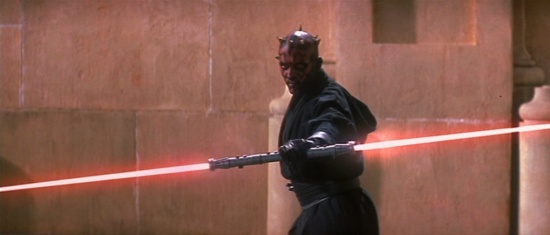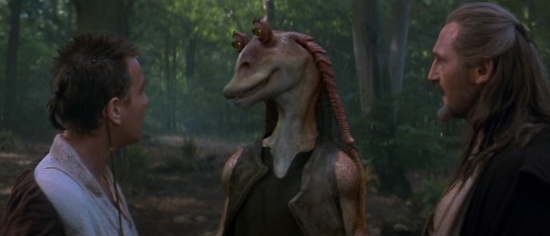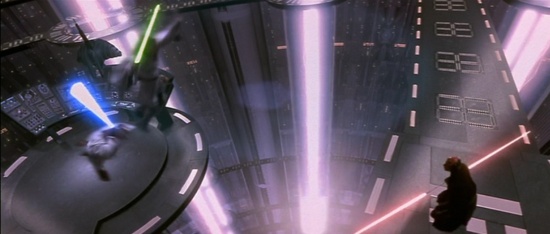The Phantom Menace (George Lucas), 1999

I guess you have to start any review of the new Star Wars movie with a little prologue explaining how excited you were to see it, how you had opening night tickets, how you queued for hours, how much Star Wars has meant to you, and so on… Well, yeah, I had opening night tickets, and yeah, I was excited, and yeah, I grew up with Star Wars and am amongst those who think that George Lucas wrought a great and marvellous thing back in 1977. I also, for the record, think The Empire Strikes Back is an even better film: one of the truly great works of fantasy cinema. But I don’t want to give the impression I went into the cinema sucked in by the hype and expecting a masterpiece. I don’t want my negative comments about the film written off as the sour grapes of someone who had waited sixteen years and could never have been pleased by Episode 1.
I actually went in with fairly neutral expectations. There were some ominous signs. I had violently disliked the Special Editions of the original trilogy, considering them at best a worrying lapse on Lucas’ part and at worst a major act of artistic self-mutilation. I was also worried first by early rumours that the film was quite juvenile in focus and then later by the negative reviews from the States. On the other hand, though, I was heartened by the assurance that the new trilogy was darker in tone (that said Empire to me), and thought the trailer was promising. And none of the reviews I had read seemed like the considered comments of a discerning Star Wars fan whose opinion I could really value. So the good and bad signs seemed balanced. At worst, I figured, the new film would be like Return of the Jedi, a film I am no big admirer of but which is at least enjoyable in an unambitious kind of way.
The new film is much worse than that. It will take a while for the fans to admit it, but the critics were right. This film is a shambles, a nearly unmitigated disaster. It is to Star Wars what Star Trek: The Motion Picture was to Roddenberry’s franchise.
The plot is largely familiar, of course, having been referred to in the original trilogy and speculated on endlessly by the fan base since. A long time ago, in a galaxy far, far away, Jedi Knights Qui-Gon Jin (Liam Neeson) and Obi-Wan Kenobi (Ewan MacGregor) discover a young boy named Anakin Skywalker (Jake Lloyd). The boy has amazing talents for a child his age, and may be the saviour of the galaxy. But the galactic Senate is in disarray, and the machinations of a menacing figure known as Darth Sidious (Ian MacDiarmid) hint at dark times ahead for the galaxy in general but for young Anakin in particular.
It’s promising material, actually, and the trajectory that this opening trilogy will follow is potentially a lot more interesting than the straight out Civil War of the first trilogy. But Lucas has, for this film at least, lost control of the material. The secrecy with which his script was guarded has become the stuff of legend: Lucas labored on it alone, and few saw it until the film was well into production. Watching the film, one can’t help but wish that Lucas had collaborated a little more with others. After all, Lucas didn’t write any of the previous films alone: Willard Huyck and Gloria Katz did a big uncredited polish on Star Wars, Jedi was co-written by Lawrence Kasdan, and Empire-the best of the three – doesn’t even have Lucas’ name on the script, being credited solely to Kasdan and Leigh Brackett. Lucas has a great imagination, but at no point in his previous career has he ever proved his capabilities as a writer.
The finished film certainly gives the impression that the script never made it past Lucas’ uncritical inner circle of yes-men. Certainly producer Rick MacCallum, if he were doing his job, should have found Lucas a collaborator or at least sent him back to work. The film is unstructured and meandering, too formless to get involved in. It rushes through an early sequence on an underwater city that has no plot relevance, then gets bogged down for an eternity on Tatooine as Qui-Gon messes around trying to free Anakin Skywalker. The dialogue is embarrasingly bad: while Star Wars dialogue was always arch, it had a certain flair that is missing here. Qui-Gon and Obi-Wan are stuck with paragraphs of Jedi pontification, while the blatantly racially coded villains get incongruous lines such as “Are you braindead?” And computer generated supporting character Jar Jar Binks (of whom more later) speaks an embarrasing baby-talk that is irritating and often impenetrable.

The human characters are unengaging: while Neeson and MacGregor do their best, they wander through the film without any real support. Jake Lloyd is good enough as Anakin but could hardly be expected to carry the film, while all the interesting actors (MacDiarmid, Terence Stamp) are given little to do. Natalie Portman is fine as a queen who is posing as a handmaiden, but queen and handmaiden are swapped several times, without the audience ever being told, so you lose track of which is which and ultimately don’t care. The unfortunate actors are backed up by a number of computer generated characters, most notably Jar Jar, an amphibious creature voiced by Ahmed Best. The character is hopelessly ill-conceived: Lucas has cynically worked in a supposed comic relief intended to appeal to children, without bothering to find a legitimate role for him to play. Hell, George, why do things by half? Next time, why not throw in Big Bird and Barney the Dinosaur?
This juvenilasation is a big problem, and it pervades the film. Children are given a lot of characters to relate to, with Jar Jar and Anakin on their level, and Portman’s character as a sort of big sister figure for Anakin. (She’s also obviously being set up as the love interest for Episode II, a development that will reverse the progression of the Luke-Leia relationship from the original trilogy). A lot of big words are thrown about during the subplot about a trade embargo, but it’s like hearing a child trying to explain foreign policy. Some plot points are spectacularly dumb, and shouldn’t have made it past the first draft (was there a second one?). Anakin, it turns out, was a virgin birth; in the single most ill-conceived scene in the film (and the series), it is also revealed that he is blessed with an impossibly high “midi-chlorian” count. Midi-chlorians, it turns out, are little symbiotic creatures that create the Force. Oh yeah? A little too much like rejected Star Trek dialogue for me, and inconsistent with both the letter and spirit of what was said about the Force in the original trilogy.
But none of this would matter if the film ever took off on an imaginative level. After all, I won’t claim that plot, dialogue and acting were ever the most crucial elements of the series (though they played their part). Ultimately, though, Phantom Menace seems disturbingly bereft of new ideas, especially given that we’re supposed to have two more films to go. Lucas is strip mining the original trilogy, reworking anything he thinks might be good for another go. Luke becomes Anakin. The Death Star becomes the Droid Ship. The invasion of Hoth becomes the invasion of Naboo. The Speeder Bikes become Pod Racers. The Ewoks become Gungans. And so on… The final battle, which intercuts between a lightsaber battle, a space battle, and a ground war, is a direct imitation of the close of Jedi, but doesn’t work nearly as well. On the way, there are some nice effects, but they’re not so much impressive as all-pervasive. Lucas has boasted that some scenes are entirely digital: translated, that means that in some sequences, nothing you see is real. It often feels that way.

Lucas is so keen to auto-plagiarise that he misses opportunities. In the final battle, there’s a three way lightsaber battle between Qui-Gon, Obi-Wan, and the villainous Darth Maul. It starts in a palace, but the three participants run through a door and continue the fight in what looks like the centre of the Death Star. It’s a completely incongruous location, so why is it there? I can only assume it’s the only environment Lucas can think of to stage such a fight. But the palace is shown as teetering on giant cliffs next to a stunning waterfall. Wouldn’t it have been great to have the fight on top of the cliffs, or leaping from rock to rock above the falls? (Imagine the lightsabers hitting the water and shooting up steam). Why not?
There are a few good elements. Neeson gives his part some authority, and MacGregor makes a pretty good stab at being a young Alec Guiness. The film’s design is often gorgeous, and to his credit, Lucas has tried to create a distinctive new look for the prequels. The pod race, while derivative, is at least moderately exciting, and the choreography of the lightsaber battle is very impressive. Yet this strange, slapdash mess of a movie is simply not in the same class as the films that inspired it. It’s too flawed to be written off as merely a disappointment, and high expectations are the least of its problems. At the first screening I saw it at, the mood of the fans going out was a kind of desperate, forced cheeriness, but the lackluster applause over the final credits told the whole story. Having wasted a whole film on finding Anakin, Lucas has a lot of plot to get through in the next two films, and it should be the more interesting section of the trilogy. But if Episode 2 is anything like this, it’s hard to know who’ll care by the time we get to number three.
Related Items
See all my Star Wars content here.